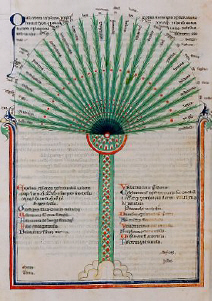THE SOUL USES THE BODY AS TOOL.
3. Whether the soul, according to her being, be located in the body, above or within this latter, the soul forms with the body an entity called (a “living being” or) organism1. In this case, the soul using the body as a tool is not forced to participate in its passions, any more than workmen participate in the experiences of their tools. As to sensations, of course, the soul must perceive them, since in order to use her instrument, the soul must, by means of sensation, cognize the modifications that this instrument may receive from without. Thus seeing consists of using the eyes; and the soul at the same time feels the evils which may affect the sight. Similar is the case with griefs, pains and any corporeal exigency; also with the desires which arise from the soul’s need to take recourse to the ministry of the body. But how do passions from the body penetrate into the soul? For a body could communicate her own properties to some other body; but how could she do so to a soul?
SEPARATION OF SOUL FROM BODY.
Such a process would imply that one individual suffers when an entirely different individual is affected. There must be a distinction between them so long as we consider the former the user, and the latter the used; and it is philosophy2, that produces this separation by giving to the soul the power of using the body as a tool.
PRIMITIVE RELATION BETWEEN SOUL AND BODY.
But what was the condition of the soul before her separation from the body by philosophy? Was she mingled with the body? If she were mingled with it, she must either have been formed3 by mixing; or she was spread all over the body; or she was4 a form interwoven with the body; or she was a form governing the body5 as a pilot governs the ship6; or7 was partly mingled with, and partly separated from, the body. (In the latter case) I would call the independent part that which uses the body as a tool, while the mingled part is that which lowers itself to the classification or rank of instrument. Now philosophy raises the latter to the rank of the former; and the detached part turns her away, as far as our needs allow, from the body she uses, so that she may not always have to use the body.
In Greek, “to zoon,” “to syntheton,” “to synamphoteron,” “to koinon,” “to eidolon.” ↩
According to the Stoics. ↩
According to Alexander of Aphrodisia. ↩
As thought Aristotle, de Anima 2.1; see Eneada-IV-3-21|4.3.21, and Numenius, 32. ↩
A famous comparison, found in Aristotle, de Anima, II. 1; Plato, Laws, x. p. 906; Cary, 14; and especially Numenius. 32. ↩
As Plotinos thinks. ↩
